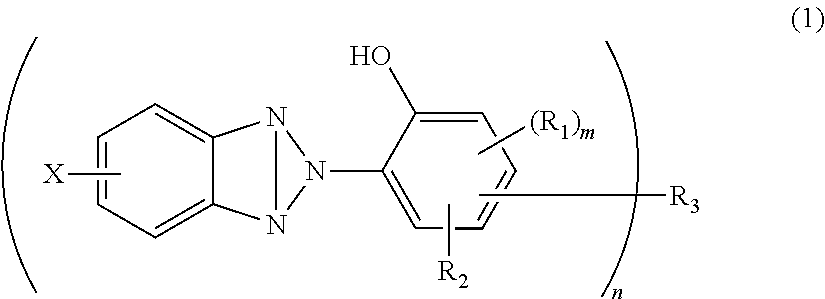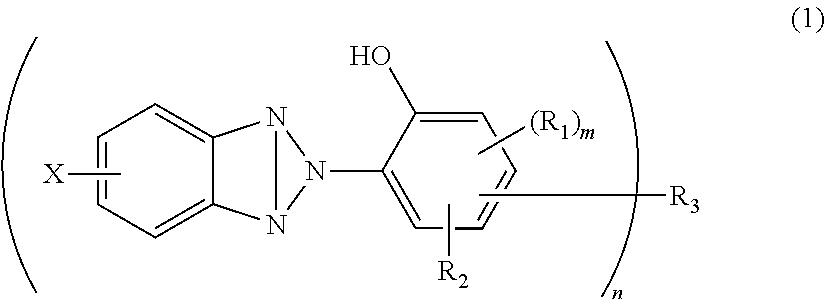Transparent plastic substrate and plastic lens
a technology of transparent plastic and transparent substrate, applied in the direction of instruments, optical elements, coatings, etc., can solve problems such as the damage of the retina by the factor, and achieve the effect of high blue light cut ra
- Summary
- Abstract
- Description
- Claims
- Application Information
AI Technical Summary
Benefits of technology
Problems solved by technology
Method used
Image
Examples
example 1
[0070]50.28 parts by mass of bis(isocyanatomethyl)bicyclo[2.2.1]heptane as a raw material monomer for a lens, 0.06 part by mass of dimethyltin dichloride as a catalyst, 0.15 part by mass of an acidic phosphate ester, JP-506H (produced by Johoku Chemical Co., Ltd.), as a releasing agent, and 1.90 parts by mass of 2-(3-tert-butyl-2-hydroxy-5-methylphenyl)-5-chloro-2H-benzotriazole as an ultraviolet ray absorbent were mixed by stirring, to which 25.50 parts by mass of pentaerythritol tetrakis(3-mercaptopropionate) and 24.22 parts by mass of 1,2-bis(2-mercaptoethylthio)-3-mercaptopropane as lens raw materials were then further added, and the components were mixed by stirring under a reduced pressure of 10 mmHg for 30 minutes, thereby preparing a monomer composition for a lens. The monomer composition for a lens was charged in a mold for molding a lens formed of a glass mold and a resin gasket (set to 0.00 D and thickness of 1.6 mm) provided in advance, and polymerized in an electric fur...
example 8
[0074]93.00 parts by mass of bis(β-epithiopropyl) sulfide and 1.00 part by mass of 2-hydroxyethyl methacrylate as raw materials for a lens, and 0.40 part by mass of 2-(3-tert-butyl-2-hydroxy-5-methylphenyl)-5-chloro-2H-benzotriazole as an ultraviolet ray absorbent were mixed by stirring, to which 6.00 parts by mass of n-butyl thioglycolate and 0.05 part by mass of tetra-n-butylphosphonium bromide as a catalyst were further added, and the components were mixed by stirring under a reduced pressure of 10 mmHg for 3 minutes, thereby preparing a monomer composition for a lens. The monomer composition for a lens was charged in a mold for molding a lens formed of a glass mold and a resin gasket (set to 0.00 D and thickness of 1.6 mm) provided in advance, and polymerized in an electric furnace at a temperature over 20° C. to 100° C. for 20 hours. After completing the polymerization, the gasket and the mold were removed, and the resulting molded article was heat-treated at 110° C. for 1 hour...
example 9
[0076]90.00 parts by mass of methyl methacrylate and 10.00 parts by mass of ethylene glycol dimethacrylate as raw materials for a lens, 1.00 part by mass of 2-(3-tert-butyl-2-hydroxy-5-methylphenyl)-5-chloro-2H-1-benzotriazole as an ultraviolet ray absorbent, and 0.10 part by mass of azobisisobutyronitrile as a thermal polymerization initiator were mixed by stirring, and the components were well agitated at room temperature and then deaerated under a reduced pressure of 50 mmHg for 10 minutes. The monomer composition for a lens was charged in a mold for molding a lens formed of a glass mold and a resin gasket (set to 0.00 D and thickness of 1.6 mm) provided in advance, and polymerized in an electric furnace at a temperature over 40° C. to 85° C. for 24 hours. After completing the polymerization, the gasket and the mold were removed, and the resulting molded article was heat-treated at 100° C. for 2 hours, thereby providing a transparent plastic lens.
[0077]The results obtained by mea...
PUM
| Property | Measurement | Unit |
|---|---|---|
| transparent | aaaaa | aaaaa |
| wavelength range | aaaaa | aaaaa |
| transparent | aaaaa | aaaaa |
Abstract
Description
Claims
Application Information
 Login to View More
Login to View More - R&D
- Intellectual Property
- Life Sciences
- Materials
- Tech Scout
- Unparalleled Data Quality
- Higher Quality Content
- 60% Fewer Hallucinations
Browse by: Latest US Patents, China's latest patents, Technical Efficacy Thesaurus, Application Domain, Technology Topic, Popular Technical Reports.
© 2025 PatSnap. All rights reserved.Legal|Privacy policy|Modern Slavery Act Transparency Statement|Sitemap|About US| Contact US: help@patsnap.com



